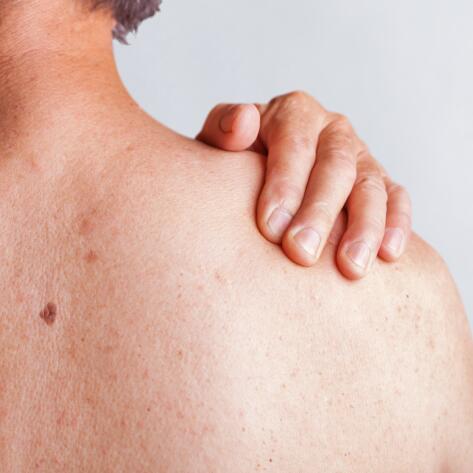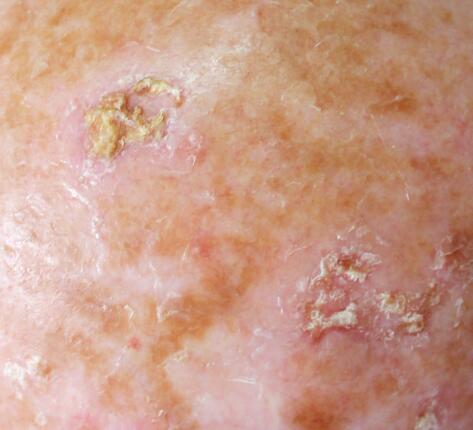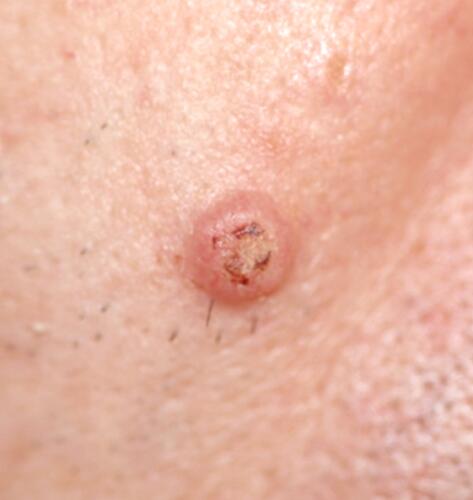Skin cancer
Skin cancer figures are rising across the world.
Every 14 seconds, a skin cancer is diagnosed worldwide. One third of all cancers diagnosed worldwide are skin cancers and 10% of these are fatal. There are two types of skin cancer: carcinomas, which are locally malignant, and melanomas, which can spread to the rest of the body and are the most dangerous type of skin cancer.
What are the symptoms, treatments and diagnoses for each type of skin cancer? What role does the sun play in the development of melanoma and how can it be prevented?

What is skin cancer?
Skin cancer is a very common form of cancer that affects the epidermis. It takes root in the melanocytes, the cells responsible for producing melanin, which duplicate in very large numbers until they cause a tumour. This melanocyte abnormality is largely due to UVA exposure. If detected early, skin cancer is a benign cancer. The removal of cancerous tissue is carried out with a local surgery. If the cancer is detected late, the prognosis is poorer, especially if cancer cells have migrated and spread throughout the body.
The role of sun radiation in skin cancer.
The sun has a cumulative action on the skin. Although it carries some benefits, as we have seen, the sun also presents many risks: sunburn, sun allergy, skin ageing, etc. Prolonged exposure to the sun without protection also has harmful consequences in the form of DNA damage. If damage caused by the sun is too extensive and accumulates over time, it can lead to skin cancer. The sun's rays include ultraviolet light (UV). UVCs are the most dangerous rays, but they are blocked by the ozone layer. UVB rays affect the cells of the epidermis, while UVA can reach the deepest layers of the dermis and thus cause DNA damage. Recently, a new enemy for the skin has been discovered: visible light radiation (as blue high-energy visible light). These rays are harmful because the attack all the cell components: lipids, proteins and DNA. The damage accumulates over the long term, hence the absolute necessity when it comes to public health to protect yourself from the youngest age and throughout life.

Different forms of skin cancer
There are several different forms of skin cancer, with two main types:
- carcinomas, which are locally malignant and for which surgery is usually sufficient treatment, except in very rare cases where oncological treatments are necessary (90% of skin cancers),
- melanomas, where the cells multiply rapidly and have a tendency to invade the rest of the body if the lesion is removed too late: this is the most dangerous type of cancer.
The different types of carcinoma
Actinic keratosis
Actinic keratosis (AK) is a pre-cancerous lesion caused by too much exposure of the skin to sunlight; it develops on exposed areas of the skin. This is considered to be the first stage leading to the development of skin cancers such as squamous cell carcinoma.
Who is affected?
Actinic keratosis is most common in people who are highly exposed to the sun, such as sailors and people living in rural areas and mountains. In Europe, 15% of men and 6% of women are affected.
How does it occur?
Actinic keratoses rarely occur as a single lesion: they spread widely to form so-called cancer fields. At first, they are too small to be seen, which means that there are always many more invisible lesions than visible ones on the skin. They then evolve into well-defined rough scaly patches which can vary in colour from red to brown. (Source: European Skin Cancer Foundation, European Dermatology Forum)
Treatment
Surgical removal, application of dry ice or liquid nitrogen or topical medications.

Squamous cell carcinoma
Squamous cell carcinoma (SCC), is the second most common skin cancer. It is a highly aggressive cancer. In most cases, squamous cell carcinomas are caused by chronic exposure to sunlight. SCC is an uncontrolled growth of abnormal keratinocytes. 40-60% of squamous cell carcinomas arise from untreated actinic keratoses.
Who gets SCC?
People aged over 60 and those working in particularly exposed professions (farmers, sailors, construction workers, etc.). Each year, approximately 1 in 1,800 people are affected by SCC.
How does it occur?
This type of cancer is characterised by a persistent rough red plaque with irregular edges. It can also take the form of a rounded open wound with raised edges. Approximately 2-10% of squamous cell carcinomas subsequently spread to the lymphatic system and become life-threatening.
Treatment
Surgical treatment, chemotherapy applied through the skin and oral or oncological treatments if the cancer has spread.

Basal cell carcinoma
Basal cell carcinoma (BCC) is the most common but least aggressive type of skin cancer - and of all organ cancers. Usually caused by a combination of cumulative and intense UV exposure and occasional exposure, basal cell carcinomas develop from the basal cells of the skin in the deepest layer of the epidermis.
Who gets BCC?
Each year, approximately 1 in 1,500 people are affected by BCC. They mainly affect people over the age of 50 and are more common in men than in women.
How does it occur?
This type of cancer appears as nodules, patches, sores or abnormal skin lumps of a red or pinkish colour on very localised areas: face, neck, hands, etc. They can cause major cosmetic damage if allowed to grow, but they do not normally spread to other organs and are only rarely life-threatening. (Source: European Skin Cancer Foundation, European Dermatology Forum)
Treatment
In the case of superficial tumours, surgery is the preferred treatment, but the doctor may also use topical medication.
Melanoma
Melanoma is the most dangerous type of skin cancer. It makes up 5% of skin cancers and 1% of malignant tumours.
Melanoma develops as a result of intense sun exposure (sunburn) rather than as a result of long-term accumulation of sun exposure, and tends to occur in people with a genetically predisposition. The tumour can occur on a pre-existing mole or on a newly synthesised mole. It originates in the melanocytes, the cells that produce melanin. Melanoma spreads relatively early to other organs through metastasis.

WE ANSWER YOUR QUESTIONS
How is melanoma diagnosed?
A melanoma often appears as a brown or multicoloured, asymmetrical, irregular spot or lump that increases in size over time and is not uncomfortable to the touch. It may start as a flat spot and then become more prominent. In rare cases, it may not be pigmented. Its resemblance to a mole can sometimes make diagnosis difficult. If in doubt, a dermatologist should be consulted for a biopsy. (Source: European Skin Cancer Foundation).
The place where skin cancer occurs varies depending on the type of melanoma, the person's sex and their phototype. Overall, malignant melanomas are found on the lower limbs, trunk, head and more rarely on the upper limbs in Caucasians, whereas the soles of the feet and mucous membranes are more common in the black race.
Although there are a variety of factors (chemical, physical, medicinal, nutritional, viral), intense and repeated exposure of certain parts of the body to the sun appears to play an active role in the appearance of melanomas. This is why it is important to stay protected from the sun by respecting the rules of exposure and choosing good protection, especially for people in phototype groups 1 and 2 who are particularly sensitive to melanomas: prevention alone is not enough to delay the appearance of tumours.
Early diagnosis increases the chances of a cure. Later diagnoses require more extensive treatment to prevent the spread of cancer cells in the body. Prevention alone cannot prevent the development this type of tumour from developing.
Melanoma treatment varies according to the stage of development: Stage I and II melanomas are treated by surgery. Stage III melanomas are treated with surgery and sometimes with Braf/Mek inhibitors or immunotherapy. Stage IV melanomas are treated with surgery, Braf/Mek inhibitors or immunotherapy.
FRIENDLY, EXPERT ADVICE
Sunburn and frequent exposure: beware!
Your skin remembers everything, like a camera film, from a very early age. In terms of sunburn, you therefore have a "quota" that you must not exceed. It’s generally accepted that it takes 10 to 15 years of excessive exposure to cause cancer. So take care of your sun capital!
To prevent melanoma from developing, you should learn to keep a close eye on your moles. Pigmented spots (and moles) are considered suspicious when they show asymmetrical changes in texture, contour and colour. If you have any doubts, consult a dermatologist.
Eau Thermale Avène's commitment to cancer prevention
Eau Thermale Avène is committed to working with the European Skin Cancer Foundation to raise awareness, educate and prevent skin cancers. And for 30 years, thanks to its unique expertise in photoprotection, Eau Thermale Avène has been working to create high quality, high-performance sun care products that guarantee optimal protection.

OUR SOLUTIONS TO PROTECT OUR FUTURE
Eau Thermale Avène skin care products designed to protect the skin and respect the oceans
NEWSLETTER
We're always here for your skin!
All our advice on how to take care of your skin day to day.

Which skin care routine should you adopt?
Identify what it really needs with the help of our experts and discover the most suitable skin care routine for you.
